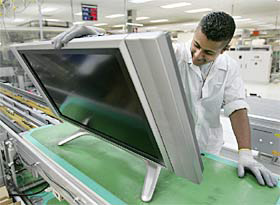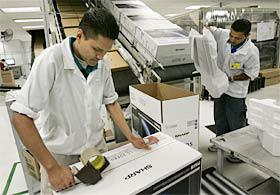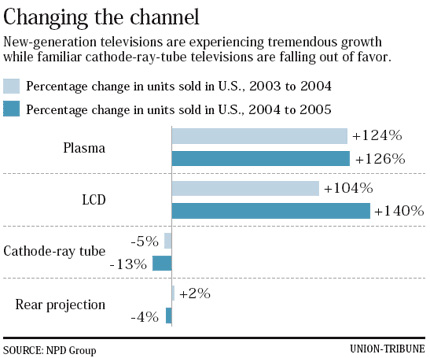 |
 |
 |
 Technology News | December 2005 Technology News | December 2005  
New-Generation TVs Put Baja Plants back on Track
 Diane Lindquist - Union-Tribune Diane Lindquist - Union-Tribune


| | Juan Jose Elvira inspected one of Sharp Electronics Corp.'s Aquos flat-screen, high-definition TV sets at its Rosarito Beach manufacturing facility in Baja California. (Nancee E. Lewis/Union-Tribune) |
Shoppers this holiday season are snatching up the newest generation of high-tech televisions and, in the process, revitalizing the Baja California factories that make them.

Plasmas, liquid crystal displays, digital-light-processing sets and other new types of TVs are among the array of selections flying out of showrooms so quickly that manufacturers can't produce enough of them.

"Consumers are buying them almost twice as fast as they adopted color sets," said Richard Dogerty, an analyst for Envisioneering, a New York-based market research firm. "This holiday season, there'll probably be a shortage of plasma TVs first and some of LCDs, which have come down in price 2-to-1 from a year ago."

The upsurge in sales is great news for television manufacturers in Baja California, which has lost its title of "Television Capital of the World" over the past five years because of a trade deal that allowed Chinese and Taiwanese TV assemblers and manufacturers to enter the U.S. market.

The newcomers then slashed prices and grabbed a larger share of traditional, cathode-ray-tube TV sales.

But technological innovations are roiling the industry again.

Next year, European broadcasters will switch from the analog signals displayed in familiar cathode-ray sets to the digital signals displayed in high-definition TV sets.

U.S. broadcasters are expected to make the change by February 2009.

Baja California's television industry is benefiting.

"We're in a recovery, fortunately," said Ryuichiro Ishikawa, Sharp's manager of corporate planning in Mexico.


| | More than 70 percent of TVs expected to be sold in the United States this year are manufactured at Baja California plants like Sharp's factory in Rosarito Beach, where worker Rubicel Ramirez (left) boxed flat-panel models. (Nancee E. Lewis/Union-Tribune) |
The surge in holiday purchases has been driven by steep price drops in the five years since the first HDTV set was sold in the United States.

On average, high-definition and other new-generation TVs cost half their price of just a year ago, though some still carry eye-popping prices.

Sets range from $350 for a 15-inch LCD to $13,000 for a 64-inch plasma.

Analysts say 3.6 million high-definition TVs will be sold this holiday season, 80 percent of what was sold during all of 2004.

"Consumers are buying just about anything that they can put on their credit cards," Dogerty said.

By the end of the year, Baja California companies will have produced 19 million sets, nearly all for the U.S. market, according to the ProduCen research center in Tijuana.

That amounts to more than 70 percent of the 26.3 million sets expected to be sold in the United States this year, according to Insight Media, an Illinois advertising and marketing firm.

Since 2003, most of the Baja television factories – companies like Hitachi, JVC, Samsung, Sanyo, LG and Panasonic – have added new-generation TV sets to their maquiladora lines.

The companies do final assembly of TV sets from components made elsewhere and they are churning out a full spectrum of sets – plasma, LCD, digital light processing, rear projections that use either cathode-ray tubes or new technology, and enhanced cathode-ray-tube televisions.

The popularity of new-generation sets "is growing regardless of whether consumers are aware of the technology," said Ross Rubin, an analyst for the NPD market research group in New York.

The sets range from small to jumbo, from lightweight to heavy, and from thick to thin – thin enough to hang on a wall. The images produced by the high-definition sets are almost lifelike in their clarity.

The new-generation sets have brought Baja California's TV industry back from a crisis that started in 2000. It was caused not only by the Chinese and Taiwanese entry into the U.S. market, after the United States signed a world telecom agreement, but also by the post-9/11 U.S. economic recession and the uncertainty about which TV technologies would be the biggest sellers.

"Companies were struggling, considering where they were going to do the manufacturing, and having China as an option," said Saul De los Santos, director of ProduCen.

Television has been a key driver of globalization, making the world smaller by projecting images around the world to rich and poor viewers alike. There are enough TV sets for roughly 1 in every 4 human beings to have one.

In the United States, the average now is 3.3 sets per household.

The TV manufacturing process also is conducted globally. Companies use labor and parts from countries that provide the best cost advantages closest to their markets. Nearly all of Baja California's TV companies are Japanese or Korean. Their suppliers are based primarily in Asia and the United States.

During the crisis, the Mexican state's 15 final assemblers held on by cutting operations, but their estimated 180 suppliers found it more difficult to survive.

"Some could cope, but others just closed and went away," said Sharp's general manager, Marco A. Esponda.

Downsizing since 2000 cost about 9,000 of the state's 43,500 television workers their jobs, according to a report that ProduCen plans to publish next month.

With the new-generation TV production, De los Santos said, the industry has recovered all but about 1,000 of the positions.

"We lost a segment of the small TVs and conventional technologies, but we gained large-screen and new technologies," he said.

Some manufacturers like Samsung and Toshiba are offering a variety of technologies; others like Sharp and Sony are concentrating on technologies they've developed.

Sharp is betting that its liquid-crystal-display technology will prove most successful in the U.S. market.

"While the crisis was going on, we were trying to decide whether to leave or not. But two years ago we decided to make the transition (to LCD sets)," Esponda said during a tour of Sharp's Rosarito Beach factory before the holiday rush. "We started with one line. Now we have four. By the end of the year, we'll be up to five."

LCD production, and that of other new technologies, requires a clean room with a controlled temperature.

The assembly process is similar to that used to make conventional TVs, but the line is configured differently. One worker now puts together an entire TV rather than add one or two parts as a set moves along the line.

"They no longer feel they are robots," Esponda said. "They're better trained, better qualified and better paid."

Assemblers of new-generation TVs in Baja California earn slightly more than $90 a week, compared with the $70 per week assemblers made when the majority of sets were traditional TVs.

Most of the new-generation TV components are made outside Baja California, however, including the flat panels that account for the bulk of a set's content.

The panels are assembled in Japan and Korea, and parent companies plan to keep production there to hone technologies and reduce prices.

As the new-generation TVs become more popular, Baja California is expected to provide an increasing share of the sets to U.S. consumers.

De los Santos predicts that in 2006, Baja California will gain $1 billion in TV-related investments.

Ya Shin, a Taiwanese firm, is in the process of setting up a plasma TV assembly plant in Tijuana. And Chinese, European and U.S. companies are discussing plans to locate in Baja California as well.

"After that," De los Santos said, "I believe we'll be way above the original pre-crisis figure in terms of employment."

Diane Lindquist: (619) 293-1812; diane.lindquist@uniontrib.com

 | 
 | |
 |



